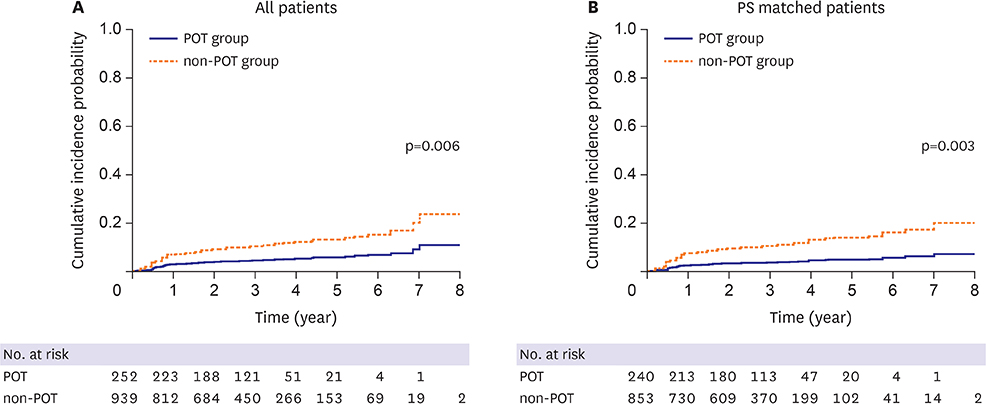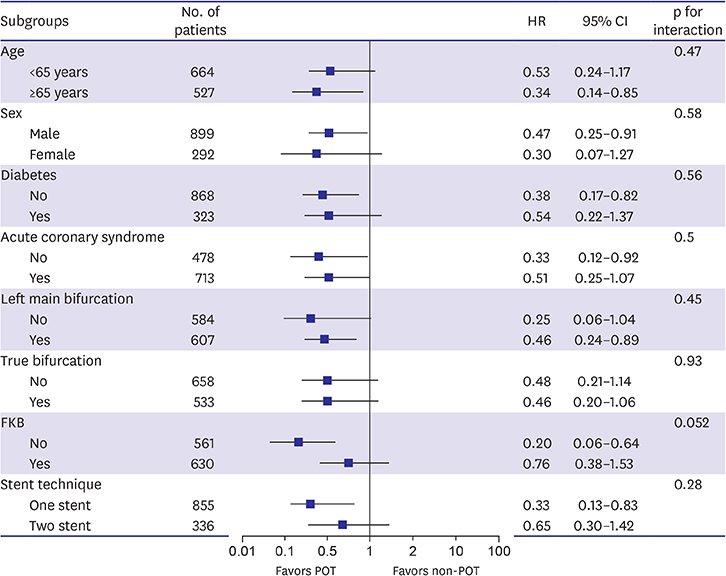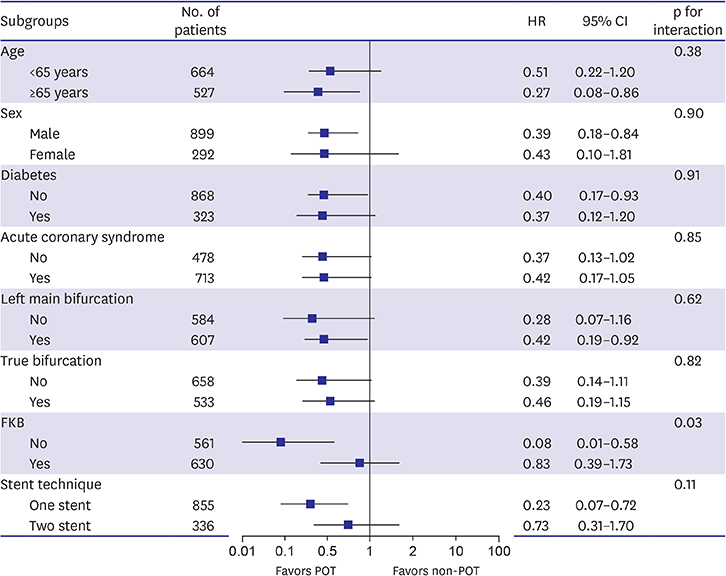Korean Circ J.
2019 Jun;49(6):485-494. 10.4070/kcj.2018.0352.
The Proximal Optimization Technique Improves Clinical Outcomes When Treated without Kissing Ballooning in Patients with a Bifurcation Lesion
- Affiliations
-
- 1Division of Cardiology, Department of Medicine, Heart Vascular Stroke Institute, Samsung Medical Center, Sungkyunkwan University School of Medicine, Seoul, Korea. hcgwon@naver.com
- 2Division of Cardiology, Cardiovascular Center, Korea University Anam Hospital, Seoul, Korea.
- 3Division of Cardiology, Department of Medicine, Samsung Changwon Hospital, Sungkyunkwan University School of Medicine, Changwon, Korea.
- 4Division of Cardiology, Department of Medicine, Seoul National University Hospital, Seoul, Korea.
- 5Division of Cardiology, Department of Medicine, Chungnam National University Hospital, Daejeon, Korea.
- KMID: 2454043
- DOI: http://doi.org/10.4070/kcj.2018.0352
Abstract
- BACKGROUND AND OBJECTIVES
There are limited data regarding the clinical efficacy of the proximal optimization technique (POT) in the treatment of coronary bifurcation lesions. We investigated the influence of POT on the clinical outcomes of patients with coronary bifurcation lesions.
METHODS
We enrolled a total of 1,191 patients with a bifurcation lesion with a side branch (SB) diameter ≥2.5 mm treated with a drug-eluting stent from 18 centers between January 2003 and December 2009. The primary outcome was major adverse cardiac events (MACEs: cardiac death, myocardial infarction or target lesion revascularization [TLR]). We performed one-to-many (1:N) propensity score matching with non-fixed matching ratio.
RESULTS
POT was performed in 252 patients. During follow-up (median 37 months), the incidence of MACE was lower in the POT group than it was in the non-POT group (adjusted hazard ratio, 0.43; 95% confidence interval [CI], 0.24-0.79; p=0.006). After propensity score matching, these were 0.34; 95% CI, 0.17-0.69; p=0.003 for MACE and 0.37; 95% CI, 0.17-0.78; p=0.01 for TLR. The use of POT was associated with significantly lower TLR in patients treated without kissing ballooning, but was not in those who underwent kissing ballooning (p for interaction=0.03).
CONCLUSIONS
In coronary bifurcation lesions with a large SB, POT may be beneficial to improve long-term clinical outcome, particularly in patients treated without kissing ballooning during the procedure. TRIAL REGISTRATION: ClinicalTrials.gov Identifier: NCT01642992
MeSH Terms
Figure
Cited by 1 articles
-
Don't Touch My POT!
Ramesh Daggubati, Kunal Brahmbhatt, Gianluca Rigatelli
Korean Circ J. 2019;49(6):495-497. doi: 10.4070/kcj.2019.0065.
Reference
-
1. Lefevre T, Louvard Y. “Everything should be made as simple as possible but not simpler”. Rev Esp Cardiol (Engl Ed). 2018; 71:418–419.
Article2. Darremont O, Leymarie JL, Lefèvre T, Albiero R, Mortier P, Louvard Y. Technical aspects of the provisional side branch stenting strategy. EuroIntervention. 2015; 11 Suppl V:V86–V90.
Article3. Mylotte D, Routledge H, Harb T, et al. Provisional side branch-stenting for coronary bifurcation lesions: evidence of improving procedural and clinical outcomes with contemporary techniques. Catheter Cardiovasc Interv. 2013; 82:E437–E445.4. Dérimay F, Rioufol G, Cellier G, Souteyrand G, Finet G. Benefits of final proximal optimization technique (POT) in provisional stenting. Int J Cardiol. 2019; 274:71–73.
Article5. Matsuda Y, Ashikaga T, Sasaoka T, et al. Effectiveness of the proximal optimization technique for longitudinal stent elongation caused by post-balloon dilatation. J Interv Cardiol. 2018; 31:624–631.
Article6. Lassen JF, Holm NR, Banning A, et al. Percutaneous coronary intervention for coronary bifurcation disease: 11th consensus document from the European Bifurcation Club. EuroIntervention. 2016; 12:38–46.
Article7. Hahn JY, Gwon HC, Kwon SU, et al. Comparison of vessel geometry in bifurcation between normal and diseased segments: intravascular ultrasound analysis. Atherosclerosis. 2008; 201:326–331.
Article8. Lansky AJ, Dangas G, Mehran R, et al. Quantitative angiographic methods for appropriate end-point analysis, edge-effect evaluation, and prediction of recurrent restenosis after coronary brachytherapy with gamma irradiation. J Am Coll Cardiol. 2002; 39:274–280.
Article9. Medina A, Suárez de Lezo J, Pan M. A new classification of coronary bifurcation lesions. Rev Esp Cardiol. 2006; 59:183.
Article10. Mintz GS, Nissen SE, Anderson WD, et al. American College of Cardiology clinical expert consensus document on standards for acquisition, measurement and reporting of intravascular ultrasound studies (IVUS). A report of the American College of Cardiology Task Force on clinical expert consensus documents. J Am Coll Cardiol. 2001; 37:1478–1492.11. Hakim D, Chatterjee A, Alli O, et al. Role of proximal optimization technique guided by intravascular ultrasound on stent expansion, stent symmetry index, and side-branch hemodynamics in patients with coronary bifurcation lesions. Circ Cardiovasc Interv. 2017; 10:e005535.
Article12. Blasini R, Neumann FJ, Schmitt C, Bökenkamp J, Schömig A. Comparison of angiography and intravascular ultrasound for the assessment of lumen size after coronary stent placement: impact of dilation pressures. Cathet Cardiovasc Diagn. 1997; 42:113–119.13. Yu CW, Yang JH, Song YB, et al. Long-term clinical outcomes of final kissing ballooning in coronary bifurcation lesions treated with the 1-stent technique: results from the COBIS II Registry (Korean Coronary Bifurcation Stenting Registry). JACC Cardiovasc Interv. 2015; 8:1297–1307.
- Full Text Links
- Actions
-
Cited
- CITED
-
- Close
- Share
- Similar articles
-
- Understanding the Coronary Bifurcation Stenting
- Angioplasty at Coronary Bifurcation
- Consecutive Jailed- and Kissing-Corsair Technique: Side Branch Protection and Dilation during Stent Implantation
- Comparative Study of Clinical and Radiographic Outcomes of High Tibial Osteotomy in Patients with Kissing Lesions and Non-Kissing Lesions
- Kissing Aneurysms at Fenestrated Proximal Basilar Artery: Double-barrel Stent-assisted Coiling Using Dual Closed-cell Stents




